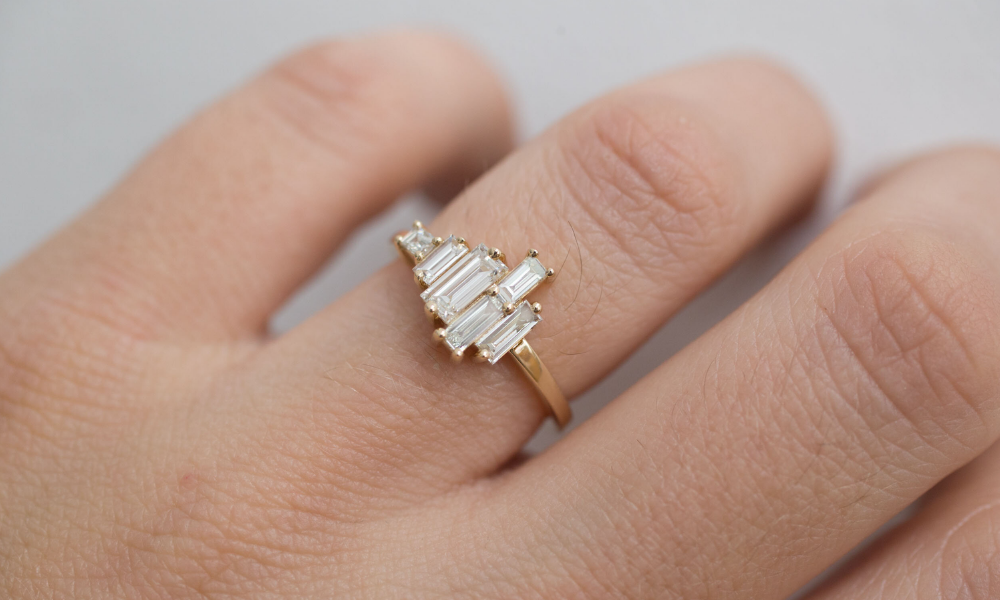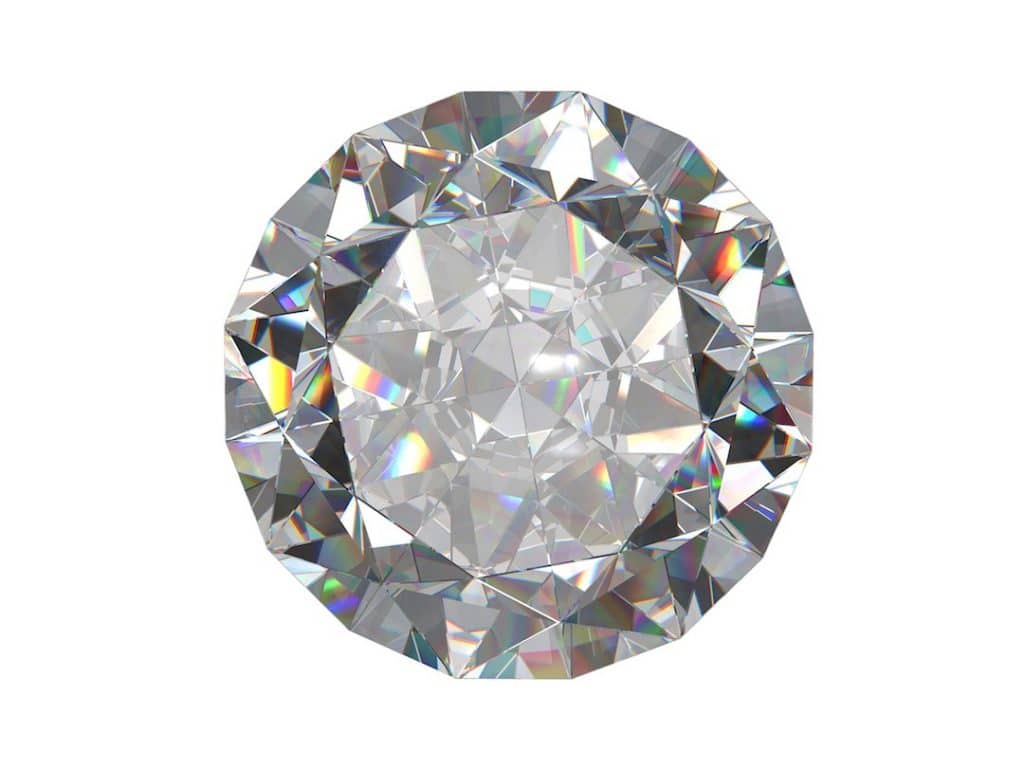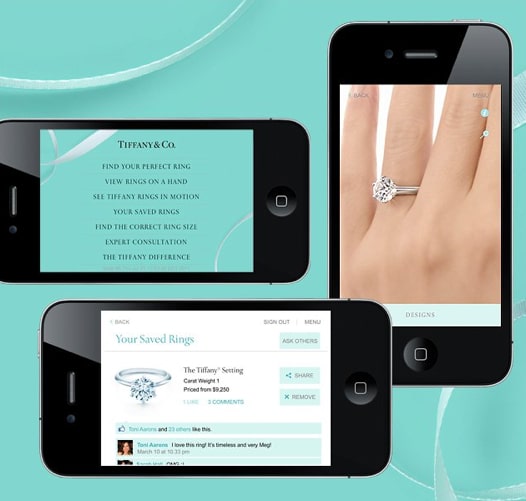When searching for the perfect engagement ring, nothing beats a ring with a diamond center stone. While most engagement rings come in the form of a traditional round-cut center stone, the stone may not be complete without some accent or side stones to elevate the ring’s beauty. The step cuts are perfect to be used as accents or side stones. However, a baguette diamond may not cross your mind straight away when you talk of step-cut diamonds. People are more familiar with the Emerald and Asscher Cuts, but baguette-cut diamonds are part of the step-cut diamond family.
If you are wondering what a baguette diamond is, if you have ever seen a long rectangular diamond set as a side stone or accent stone, you may have probably seen a baguette diamond. They can also be tapered, and a typical baguette has 14 facets. Despite being used as a traditional side stone for rings, baguettes are also as important in the piece because they draw more attention to the center stone.
If you are new to diamonds, you may not necessarily know a lot about baguette diamonds; however, in this article, I will be diving deep into what baguette diamonds are, what makes them different from other step cut diamonds, and I will also be giving my thoughts on baguette diamonds and whether you should get them or not. But before we get started, let us understand diamonds and why the baguette cut is different from other cuts.

What Are Baguette Diamonds?
A baguette diamond is a slender cut of diamonds under the step-cut family, mainly used as a side stone or an accent stone to amplify the overall beauty of a jewelry piece. A baguette-cut diamond looks similar to the emerald cut but with an elongated profile and right-angled corners. The baguette diamond also features 14 facets, and it is normally cut in a 5:1 ratio.
A baguette does not always have to be a diamond because almost every gemstone can be cut into a baguette. The main characteristics of baguettes include their small sizes and their rectangular or elongated shape. A baguette can also have tapered edges instead of a straight rectangular body. A baguette diamond does not have a lot of facets; instead, it has long parallel step cuts along the sides.
What Is A Baguette Diamond Used For?
Because of the small size of baguettes, they are mainly used to show off or draw attention to a much bigger stone which is supposed to be the main attraction of the piece. Apart from being accent or side stones, they can be assembled to form a larger, more interesting design. You would usually see baguettes on the shank of engagement rings, and they run from the shoulders to the shank to create an impression that the shank is diamond as opposed to metal when you look at it from the top.
Baguette diamonds are not only found on engagement rings; you can also spot these stones on eternity bands. They can be arranged horizontally with the flow of the band or vertically against the flow of the band; either way, you would still get beautiful results (each creates a unique look for the band).
Some of the most popular settings for baguette diamonds are the “three-stone set,” “the channel set,” and “the ballerina.” These settings may be different, but they all provide beautiful aesthetics to the jewelry piece.
- The three-stone set features two baguette stones set side by side to call attention to the round center stone.
- The channel set has a more simple but sophisticated look. The baguette diamonds are placed in a way that outlines the shape of the round center stone; this places more emphasis on it.
- Just as the name suggests, the ballerina setting is fanciful, and a ballerina’s tutu inspired it. It features tapered baguettes that are placed outwards from the center stone, but you can also see other variations of the ballerina engagement ring setting.
History Of Baguette Diamonds
If you have ever heard that baguette diamonds were named after the French bread, you are not far from the truth. The baguette cut diamond is not named after the French bread. However, the French word “baguette” translates to “stick” in English, and it also gets its name from the word “bague,” which is an old phrase that means “small jewel” in English.
Before the baguette cut was introduced, another diamond cut was called the “hogback cut,” and it was very popular in the mid 16th century.
Between the 1920s and 1930s, the baguette cut was created. It became the leading style in the Art Deco era thanks to the renowned jewelry houses Cartier and Harry Winston, who re-popularized the baguette-cut diamond in 1912. The baguette diamonds were welcomed by western society because of their functionality and because they are a lot different from traditional round cut stones; the Baguette was worn by those who wanted to stand out from the crowd.
What Makes A Baguette Different From Other Step-Cuts?
Baguette diamonds may look similar to emerald cut diamonds, but even someone new to jewelry would tell you they are different after a second look. If you do not have the time to inspect these stones closely, there are some key factors to know about when looking for a baguette diamond. These are what distinguishes baguette diamonds from other diamonds in the step-cut family.
The Edges
Traditional step-cut diamonds like the Emerald and Asscher cuts all have wedged edges. In contrast, a baguette diamond almost always has straight corners, except when tapered to have a smaller bottom. The cropped edges of these other step-cut diamonds make them easily distinguishable from baguette diamonds, so if you are in a jewelry store but you are unsure of the stone you’re looking at, try taking a closer look at the corners of the gemstone to see if they are cropped or straight.
Facets
As I previously mentioned, baguette diamonds usually have only 14 facets, making them good on the shoulder of engagement rings. Although there are some cases where a baguette can have up to 24 facets (which is the maximum for it), it still doesn’t come close to the 57 to 58 facets of other step-cut diamonds. The baguette cut features fewer facets than other step-cuts, so a useful tip for determining a baguette would be to look at the facets; it has fewer facets and straight edges, then it most definitely is a baguette diamond.
Brilliance
Another obvious feature of baguette diamonds is that they do not reflect as much light as other diamonds; even the emerald and Asscher cut diamonds sparkle more than a baguette-cut diamond. A diamond reflects more light when it is cut. More cuts (facets) by a professional diamond cutter means that the diamond sparkles more; however, the baguette cut is different because it features fewer facets than a typical diamond. This isn’t a bad feature because less sparkle means the center stone on the jewelry would get the most attention, and this is what most jewelers look for in accent stones.
Why You May Consider Getting Baguette Diamonds
Shopping for pieces of jewelry may not be the most straightforward task; you have to put a lot of things into consideration, not just the price. There are other step-cut diamonds in the market, so why should you pick a much smaller Baguette cut diamond?
I have made a list of reasons you should consider getting a baguette diamond instead of an emerald or Asscher diamond. Based on my analysis, the list was made, so feel free to pick other diamonds if you still don’t want a baguette. But without further ado, these are some reasons why you should consider getting a baguette diamond.
Baguette Diamonds Are Economical
You would get to see baguette diamonds in some high-end luxury stores. Still, unlike other step-cut diamonds, baguette diamonds are relatively lower in price than other step-cut diamonds. Baguettes are one of the cheapest diamonds you can purchase from the market.
Despite their low price, baguette diamonds do not fall short in quality, making them good value for money. The main reason baguette diamonds are cheaper than other diamonds is their small size and because it isn’t so fancy to look at.
Baguette Diamonds Can Be Set In Numerous Ways
Have you ever grown tired of a piece of jewelry and wanted to reset or restyle it? Well, it is much easier with baguette diamonds. The small diamonds can be set in different ways, and they would still look good despite the setting in which they find themselves.
You can place baguettes horizontally, vertically, or in a specific pattern. It is open to a world of endless possibilities, you need to be creative, and baguette diamonds are versatile enough to get the job done.
Baguette Diamonds Are Good Side Stones
Unlike other step-cut diamonds, baguette diamonds do not feature many facets, and as a result, it does not have so much brilliance and fire. This makes them the perfect side stones because they can be used to outline the center stone on an engagement ring, and they would still not take away the attention from the center stone. When you flaunt your diamond ring, you want people to focus on the centerpiece, which is supposed to have more sparkle, and not the side stones.
Why You May Opt Out Of Getting Baguette Diamonds
As incredible as baguette diamonds sound, there are some downsides to them, and it is only fair to talk about the good and the bad sides of these diamonds. Before you get a piece of jewelry, you should know exactly what you are getting, and you don’t want to regret getting them in the long run, so let us take a look at the cons of baguette diamonds and why you may want to rethink buying them.
Baguette Diamonds Are Not Good For Solitaires
Not to get confused with the game, a jeweler’s definition of solitaire is a piece of jewelry set with one gemstone; this also includes pendants and earrings. Despite baguettes having great corners and shape, it is not suitable to be used on their own; it works better as an accent or side stone; the beauty of these stones is seen when they are in clusters.
Baguette Diamonds Have Less Brilliance
Baguette diamonds have fewer facets; as I mentioned before, facets of a gemstone allow more light to bounce off it, making the gemstone sparkle more. With baguette diamonds, the facets are usually just 14, which means it does not reflect as much light as other diamonds. If you want a diamond with a lot of fire and brilliance, then baguette diamonds would not be perfect for the occasion.
Scratches Are Visible On Baguette Diamonds
One of the major characteristics of diamonds is their ability to hide scratches and other marks, and diamonds are considered the most durable material on earth. However, you would get to see inclusions and flaws with the baguette diamond.
Unavailability Of Baguette Diamonds
Despite baguettes diamonds being the perfect accent stones, many people do not put them on their jewelry today because the diamond cut is not so popular in some regions. Because of this, many jewelry stores do not stock up on baguette diamonds, making them almost inaccessible for many jewelry lovers.
Conclusion
Jewelry comes in different shapes and sizes; one of the most prestigious gemstones in gemology is the naturally formed diamond. Diamonds also come in different shapes and sizes, and whether it is a big or small stone, it is still valuable and beautiful.
The baguette-cut diamonds are usually about 5:1 in length and width, making them relatively small to other step-cut diamonds. However, this size doesn’t limit the importance of baguette diamonds. These stones are perfect when used as side stones or accent stones; they are rarely spotted independently, as they work better in clusters.
Before getting baguette diamonds, you should know some things about them, and this article will guide you through your quest for getting the right baguette diamond.







